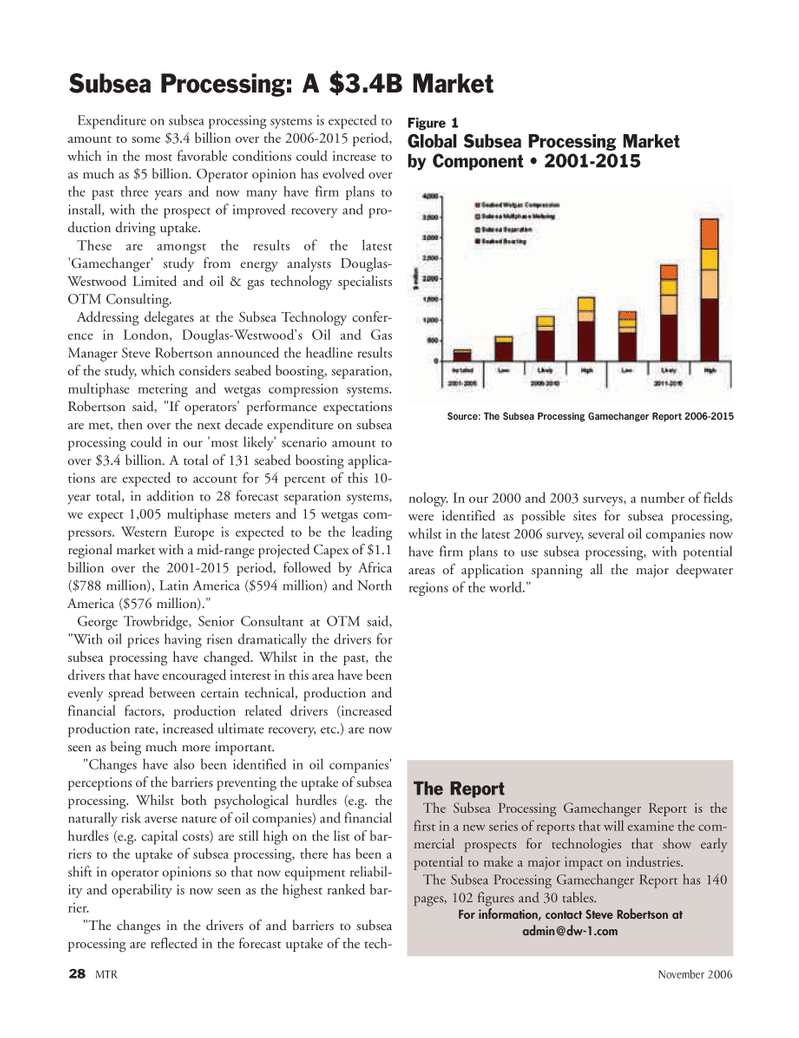
Page 28: of Marine Technology Magazine (November 2006)
Deep Ocean Exploration
Read this page in Pdf, Flash or Html5 edition of November 2006 Marine Technology Magazine
28 MTR November 2006
Expenditure on subsea processing systems is expected to amount to some $3.4 billion over the 2006-2015 period, which in the most favorable conditions could increase to as much as $5 billion. Operator opinion has evolved over the past three years and now many have firm plans to install, with the prospect of improved recovery and pro- duction driving uptake.
These are amongst the results of the latest 'Gamechanger' study from energy analysts Douglas-
Westwood Limited and oil & gas technology specialists
OTM Consulting.
Addressing delegates at the Subsea Technology confer- ence in London, Douglas-Westwood's Oil and Gas
Manager Steve Robertson announced the headline results of the study, which considers seabed boosting, separation, multiphase metering and wetgas compression systems.
Robertson said, "If operators' performance expectations are met, then over the next decade expenditure on subsea processing could in our 'most likely' scenario amount to over $3.4 billion. A total of 131 seabed boosting applica- tions are expected to account for 54 percent of this 10- year total, in addition to 28 forecast separation systems, we expect 1,005 multiphase meters and 15 wetgas com- pressors. Western Europe is expected to be the leading regional market with a mid-range projected Capex of $1.1 billion over the 2001-2015 period, followed by Africa ($788 million), Latin America ($594 million) and North
America ($576 million)."
George Trowbridge, Senior Consultant at OTM said, "With oil prices having risen dramatically the drivers for subsea processing have changed. Whilst in the past, the drivers that have encouraged interest in this area have been evenly spread between certain technical, production and financial factors, production related drivers (increased production rate, increased ultimate recovery, etc.) are now seen as being much more important. "Changes have also been identified in oil companies' perceptions of the barriers preventing the uptake of subsea processing. Whilst both psychological hurdles (e.g. the naturally risk averse nature of oil companies) and financial hurdles (e.g. capital costs) are still high on the list of bar- riers to the uptake of subsea processing, there has been a shift in operator opinions so that now equipment reliabil- ity and operability is now seen as the highest ranked bar- rier. "The changes in the drivers of and barriers to subsea processing are reflected in the forecast uptake of the tech- nology. In our 2000 and 2003 surveys, a number of fields were identified as possible sites for subsea processing, whilst in the latest 2006 survey, several oil companies now have firm plans to use subsea processing, with potential areas of application spanning all the major deepwater regions of the world."
Subsea Processing: A $3.4B Market
Figure 1
Global Subsea Processing Market by Component • 2001-2015
Source: The Subsea Processing Gamechanger Report 2006-2015
The Report
The Subsea Processing Gamechanger Report is the first in a new series of reports that will examine the com- mercial prospects for technologies that show early potential to make a major impact on industries.
The Subsea Processing Gamechanger Report has 140 pages, 102 figures and 30 tables.
For information, contact Steve Robertson at [email protected]
MTR#9 (17-32).qxd 11/13/2006 4:48 PM Page 28

 27
27

 29
29
